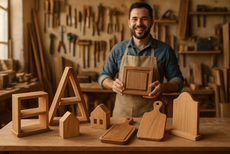How to Choose the Right Photo for a Canvas Print (And What to Avoid)
Canvas prints have become a popular way to transform everyday photos into timeless wall art. Whether you’re decorating a New York loft or a cozy suburban home, canvas wall art adds warmth, texture, and personality to any space. But not all photos are equally suited for canvas printing.
Choosing the right image is key to getting a stunning result that not only looks good up close but also holds visual appeal from across the room. Here’s a guide to help you pick the perfect photo for your canvas—and what common mistakes to avoid.
1. Start with High Resolution
The most important factor for a quality canvas print is image resolution. Because canvas prints are often enlarged, any flaws or pixelation in the image will become more noticeable.
What to do:
- Use photos that are at least 300 DPI at the desired print size.
- For an 18×24” canvas, aim for a photo that’s 5400 x 7200 pixels.
- Original images from DSLR cameras or modern smartphones typically work well.
Avoid:
- Screenshots or images saved from social media.
- Zoomed-in or heavily cropped photos that reduce resolution.
2. Choose Photos with Strong Composition
Not all good photos translate well to large-scale prints. Look for images with a strong focal point and balanced composition.
Best suited for canvas wall art:
- Landscapes with clear horizons or natural symmetry.
- Portraits with clean backgrounds and centered subjects.
- Abstract or close-up shots with bold details and minimal clutter.
Avoid:
- Busy backgrounds that distract from the main subject.
- Photos with too many small elements that get lost when enlarged.
3. Mind the Edges: Leave Room for Wrapping
Unlike traditional prints, canvas prints are often gallery-wrapped—meaning the photo wraps around the edges of the wooden frame. This can slightly crop the image, especially around the borders.
What to do:
- Choose photos with some margin or negative space around the main subject.
- Use editing tools to add a border if needed.
- Preview the canvas wrap online before finalizing.
Avoid:
- Important elements like faces or text near the edges of the frame.
4. Pay Attention to Lighting and Color
Lighting can make or break the impact of canvas printing. Bright, well-lit images with natural or soft lighting tend to look better than those taken in low light.
Ideal lighting conditions:
- Golden hour shots for a warm glow.
- Natural daylight for portraits or interiors.
- High-contrast photos for bold, modern spaces.
Avoid:
- Overexposed highlights or underexposed shadows.
- Filters that distort true color tones.
5. Match the Photo Style to Your Space
The image you choose should complement your home or office décor. A minimalist modern apartment in New York might call for sleek black-and-white photography, while a farmhouse-style interior may favor rustic or nature-inspired imagery.
Ideas by style:
- Urban/Modern: Street photography, skylines, geometric art.
- Rustic/Traditional: Family portraits, countryside scenes.
- Bohemian: Nature elements, dreamlike landscapes, abstract textures.
Avoid:
- Mismatched themes that disrupt the mood of your space.
6. Consider Orientation and Placement
Before you choose your photo, think about where it will hang. Vertical or horizontal orientation can dramatically affect how it fits the room.
Tips:
- Horizontal images work well above sofas, beds, or dining tables.
- Vertical shots are great for narrow wall spaces or stairways.
- Square canvases are ideal for gallery walls or standalone pieces.
Avoid:
- Cropping an image unnaturally just to fit a space—use editing tools to adjust proportion properly.
7. Don’t Over-Edit or Over-Filter
Editing can enhance a photo, but too much retouching can make it look artificial once printed on canvas. Excessive filters or color adjustments may appear distorted in print.
What to do:
- Use light editing to correct brightness, contrast, or color balance.
- Stick to natural tones unless going for a specific artistic effect.
- Preview a print mockup before finalizing the order.
Avoid:
- Grainy or noisy effects.
- Over-sharpening or color saturation that may look unnatural on a larger scale.
Don’t Over-Edit or Over-Filter
Editing can enhance your photo, but overdoing it can reduce quality in canvas printing. Too many filters or excessive sharpness may look unnatural. Aim for subtle adjustments to keep your canvas prints clean, timeless, and true to life.
Final Thoughts: Choose with Intention
Canvas wall art is more than just decor—it’s a reflection of personal memories, passions, and style. By carefully selecting a high-quality image, paying attention to detail, and matching your print to your space, you’ll create a piece that not only looks stunning but also lasts for years.
Whether it’s a serene landscape, a family portrait, or a snapshot from your favorite vacation, thoughtful selection and smart preparation with Baboo Digital will make your canvas prints truly stand out.




